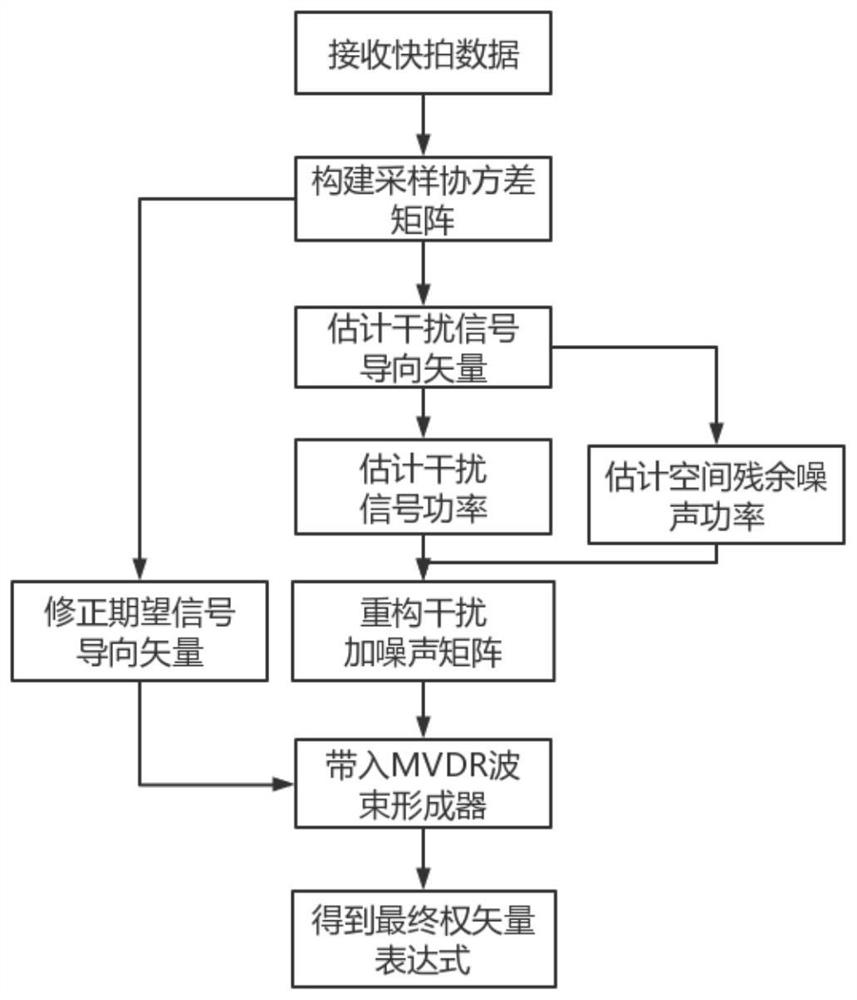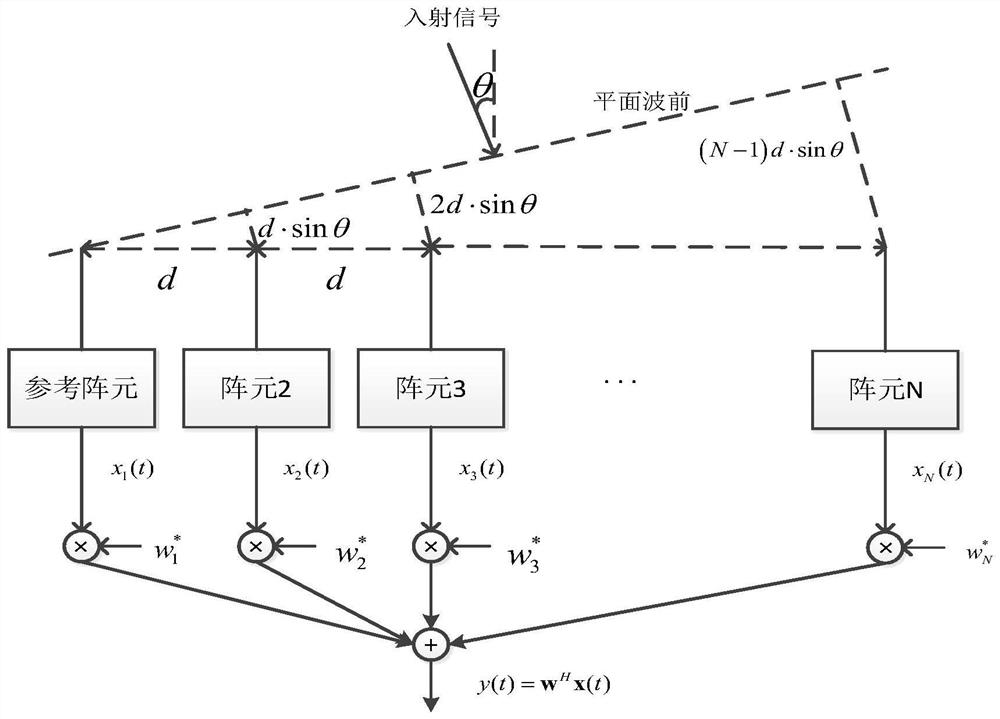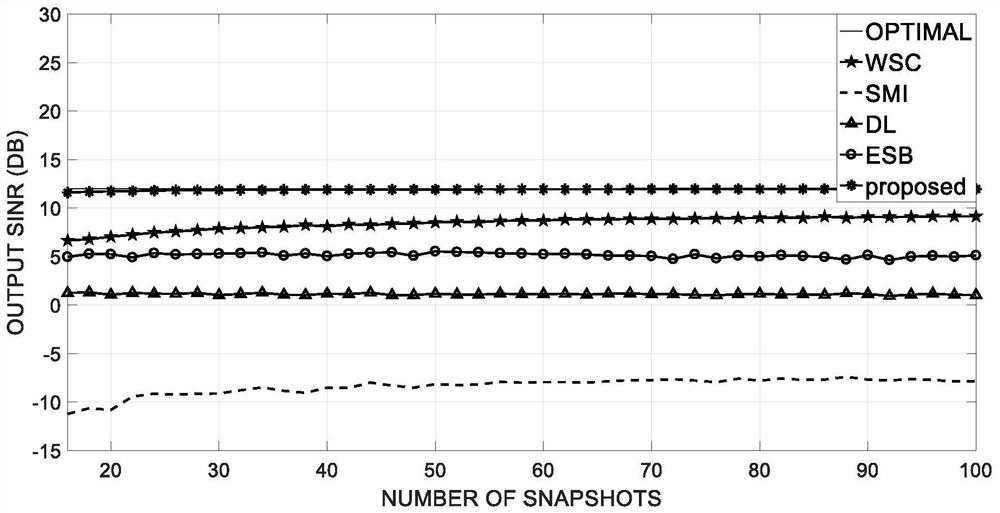Beam forming method based on expected steering vector estimation and matrix reconstruction
A technology that expects steering vector and steering vector, applied in radio wave measurement systems, instruments, etc., can solve problems such as general performance, and achieve the effect of improving performance, improving output signal-to-interference noise ratio, and improving output performance
- Summary
- Abstract
- Description
- Claims
- Application Information
AI Technical Summary
Problems solved by technology
Method used
Image
Examples
Embodiment 1
[0103] refer to Figures 1 to 2 , which is an embodiment of the present invention, provides a beamforming method based on expected steering vector estimation and matrix reconstruction, including:
[0104] S1: construct a sampling covariance matrix according to the data received by the array;
[0105] Further, the data received by the array is the signal received by the array, it can be seen that figure 2 , which shows a model of a uniform linear array receiving signal. The signal received by the array is set as a far-field narrowband signal. Taking a uniform linear array as an example, it can be expressed as:
[0106]
[0107] where x i (t) represents the signal received by the i-th array element, and N represents the number of array elements;
[0108] It should be noted that the uniform linear array is a basic array form proposed according to the antenna electromagnetic field theory and objective laws. It is a commonly used analytical model for sonar or radar signal pr...
Embodiment 2
[0191] refer to image 3, which is an embodiment of the present invention, provides a beamforming method based on expected steering vector estimation and matrix reconstruction. In order to verify the beneficial effects of the present invention, scientific demonstration is carried out through simulation experiments.
[0192] A uniform linear array with 16 array elements received three far-field narrowband signals, in which the desired signal was incident from -0°, and the interference signal was incident from -30° and 40°, respectively, and the array element spacing was half wavelength. The simulation objects include Worst Case Optimal Algorithm (WSC), Diagonal Loading (DL), Eigen Subspace (ESB), and Sampling Matrix Inversion (SMI), as well as the proposed algorithm (proposed) for comprehensive simulation. Simulation results are used to analyze the advantages of the present invention, wherein the error range of the WSC algorithm is set to 3, and the diagonal loading factor of t...
Embodiment 3
[0195] refer to Figures 4 to 5 , which is an embodiment of the present invention, provides a beamforming method based on expected steering vector estimation and matrix reconstruction. In order to verify the beneficial effects of the present invention, scientific demonstration is carried out through simulation experiments.
[0196] Same as the previous embodiment, a uniform linear array with 16 array elements receives three far-field narrowband signals, where the desired signal is incident from -0°, and the interference signal is incident from -30° and 40°, respectively. The element spacing is half wavelength. The simulation objects include Worst Case Optimal Algorithm (WSC), Diagonal Loading (DL), Eigen Subspace (ESB), and Sampling Matrix Inversion (SMI), as well as the proposed algorithm (proposed) for comprehensive simulation. Simulation results are used to analyze the advantages of the present invention, wherein the error range of the WSC algorithm is set to 3, and the di...
PUM
 Login to View More
Login to View More Abstract
Description
Claims
Application Information
 Login to View More
Login to View More - Generate Ideas
- Intellectual Property
- Life Sciences
- Materials
- Tech Scout
- Unparalleled Data Quality
- Higher Quality Content
- 60% Fewer Hallucinations
Browse by: Latest US Patents, China's latest patents, Technical Efficacy Thesaurus, Application Domain, Technology Topic, Popular Technical Reports.
© 2025 PatSnap. All rights reserved.Legal|Privacy policy|Modern Slavery Act Transparency Statement|Sitemap|About US| Contact US: help@patsnap.com



